Which Of The Following Words Suggests A Point Of View?
'Point of view' is one of the first elements of storytelling an author has to decide upon when writing fiction. POV, as it's often known as, is all about narrative voice: who's telling your story, and how is it being filtered to the audience? Telling your story in the first, second, or third person will affect how it unfolds, its mood and tone, and many other aspects of the storytelling process. They can all be successful — but not all of them will be right for your story.
To tell which point of view is being used, identify the most commonly used pronouns in the piece:
- Third person uses he/she/they: "They had decided to have breakfast tomorrow morning, but she wasn't invited."
- Second person is told through you: "You crack open the door of the mansion, and you find a woman sitting alone on a chair."
- First person employs I or we: "When I heard her name, I felt a strange sensation in my stomach."
This guide will look at the major types of points of view and provide examples that will help you understand them better. Let's get started.
🖊️
Which POV is right for your book?
Take our quiz to find out! Takes only 1 minute.
Types of points of view (with examples)
Though it might be confusing, there are actually four types of point of view. The third person is subdivided into 'limited' and 'omniscient.' The following section will take you on a whistlestop tour of all major POVs and provide you with some examples too.
First person
A first person narrative is common to all of us and relatively intuitive to write because it's how we tell stories in everyday life. It's typical for a first person narrator to be the protagonist of a story, like Holden Caulfield in JD Salinger's Catcher in the Rye. An example would be a sentence with first person pronouns, such as:
"Bring me the prisoner," I told my chief of police.
First person can create intimacy between the reader and the characters, granting us access to their emotions, psyches and inner thoughts. It's no surprise that it's often used for coming-of-age stories where explicitly emotional themes of angst and isolation come to the fore.
The drawback is that having a single narrator can be limiting to the scope of a story. The reader can only know what the narrator knows. It's also said that a first person narrator is biased, but of course, unreliable narrators can be intentional and fascinating literary projects in themselves.
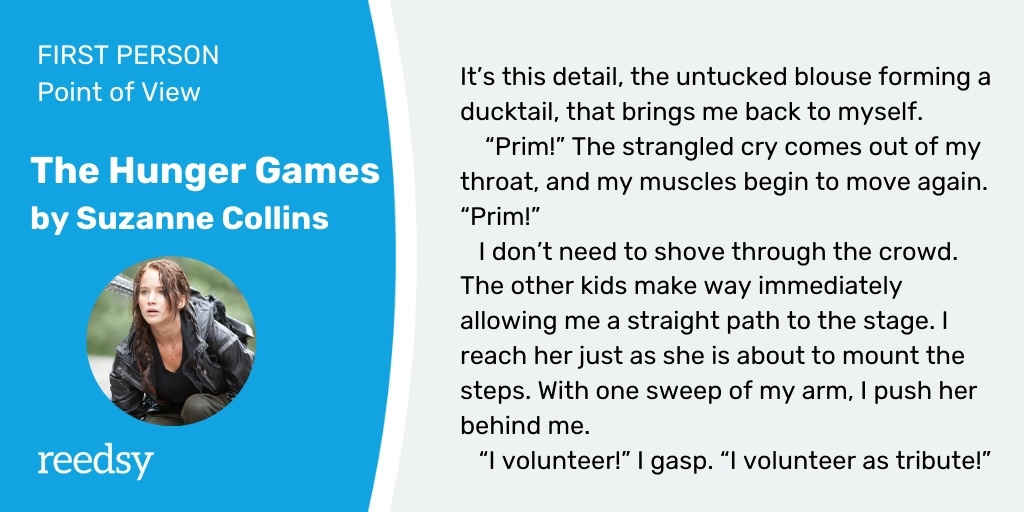 In Suzanne Collins's The Hunger Games, we follow our young narrator, Katniss Everdeen, as she volunteers in place of her sister for the Hunger Games — a televised dystopian event involving tributes 'fighting' to the death in a dangerous public arena. Throughout the trilogy, we hear things from Katniss's perspective. It gives us a sense of her inner thought processes as she experiences (and is often the center of) life-changing events for her and those around her.
In Suzanne Collins's The Hunger Games, we follow our young narrator, Katniss Everdeen, as she volunteers in place of her sister for the Hunger Games — a televised dystopian event involving tributes 'fighting' to the death in a dangerous public arena. Throughout the trilogy, we hear things from Katniss's perspective. It gives us a sense of her inner thought processes as she experiences (and is often the center of) life-changing events for her and those around her.
Flowers for Algernon is an example where plot detail can be limited by a first-person narrative:
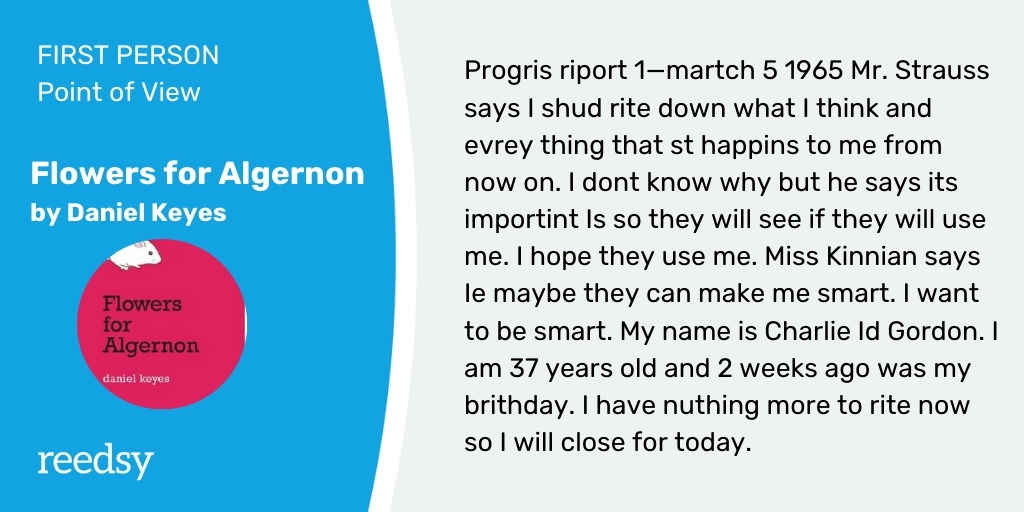
As you can see, Keyes made a daring choice by narrating his story through Charlie Gordon, a student who hasn't quite got to grips with spelling and grammar yet. It makes the text a bit disorienting, which might be a turn-off for readers desiring, clear, uncomplicated prose. However, it is a popular way to fully immerse readers in the psyche of the protagonist and initiate some character development using the book's actual format — not just description.
Irvine Welsh cult classic Trainspotting also found great success, and it's written entirely in a working-class Edinburghian dialect. Despite using vocabulary, phrases, and syntax that were unfamiliar to much of his readership, Welsh's brilliant storytelling submerged his audience in the community and events he was describing.
Second person
Second person narratives are less common. It's all about putting the reader directly in the headspace of a particular character: either the protagonist or a secondary figure. The pronouns associated with second person include you, your, and yours, as in:
You instruct the chief of police to bring the prisoner to your office.
Of all the POVs, this is the least popular — mainly because it requires such a large suspension of disbelief on the part of the reader. When executed well, it can appear impressive and technically accomplished. However, it tends to be more suited to shorter, lyrical pieces of writing (like poetry), or as a means to provide variety in a longer novel that has chosen a different POV as its basis.
N.K. Jemisin's The Fifth Season is an example of how second person narratives can draw a reader into the story.
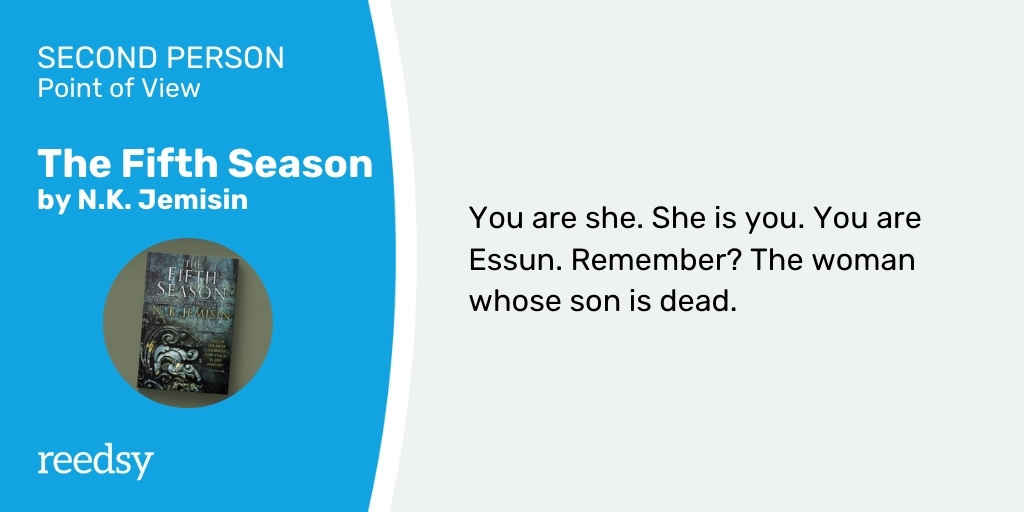
This sci-fi fantasy thriller tells the story of Stillness, an alternate world plagued by constant seismic activity. The plot hinges upon the Sazne people, who aren't quite sure how to look after a planet that is causing them turmoil, despite harnessing the power of 'oregenes', people born with an ability to control the environment.
Only one section of this book is written in second person — it arguably works because the whole story isn't using this narrative, which can be alienating if overdone. Here, though, it's an interesting and compelling addition, and very effective in eliciting an emotional response.
Alternatively, Jay McInerney Bright Lights, Big City shows how second person narratives can provide an unusually direct reading experience:
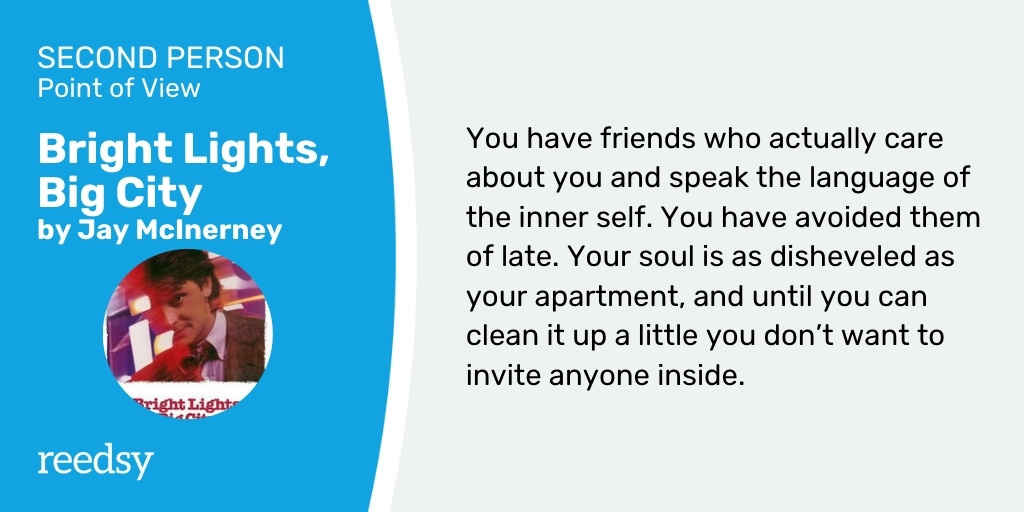
Bright Lights, Big City follows a magazine fact-checker at a magazine living in the 1980s New York City fast lane. It's a high octane, fast-paced read about a lifestyle most people don't experience first hand, which is perhaps why McInerney opted for second person POV. It makes for a refreshing change from what is typical in modern classics like this one.
Third person (limited)
Everyone's read a third person limited narrative. This POV uses third-person pronouns such as "he" and "she" to relate the story:
"Bring me the prisoner," she told her chief of police.
Third person limited is where the narrator can only reveal the thoughts, feelings, and understanding of a single character at any given time — hence, the reader is "limited" to that perspective. For instance:
"She couldn't tell if the witness was lying."
In this example from Eleanor & Park, author Rainbow Rowell builds intimacy between the reader and her characters with a third person limited narrator. 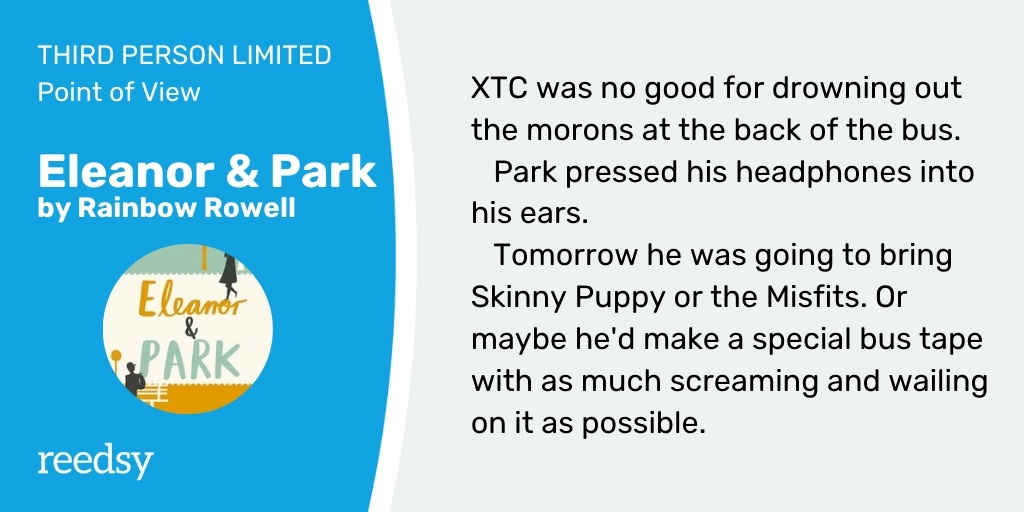 In this excerpt, we're presented with the perspective of Park, a music-obsessed, semi-reclusive "boy at the back of the bus," who's about to fall head over heels in love with Eleanor. Park is trying his best to blend into the background, and we get a fuller picture of his withdrawn nature via his inner monologue.
In this excerpt, we're presented with the perspective of Park, a music-obsessed, semi-reclusive "boy at the back of the bus," who's about to fall head over heels in love with Eleanor. Park is trying his best to blend into the background, and we get a fuller picture of his withdrawn nature via his inner monologue.
Eleanor & Park is a romance novel — a genre that limited third person is great for: giving only one side of a will-they-won't-they story is a brilliant way to add intrigue and suspense. This element of 'not knowing' is what makes love in real life so anguish-inducing too, right?
Similarly, JK Rowling's Harry Potter series shows how third person narratives have mainstream appeal:
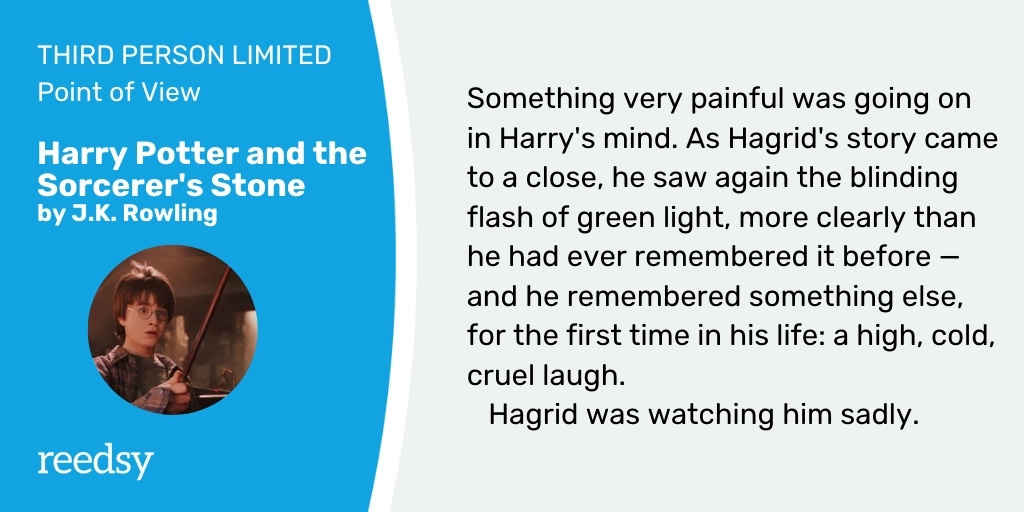
As you can see in the excerpt, third person limited POV is clear and effective, which makes it a popular way to tell a story. Harry Potter has a dedicated fanbase the world over in part because the character of Harry Potter was so well developed, as the third person limited POV fostered an emotional closeness between him and the readers.
Third person (omniscient)
Third person omniscient is a little different. As you might be able to tell, this type of narration is "all knowing" — they're not just limited to one character's perspective and information, but instead can reveal anything that is happening, has happened, or will happen in the world of the story. For example:
- He thought the witness was honest, but she didn't think the same of him.
It's a popular point of view because it allows a writer to pan out beyond the perspective of a single character. That means new information (beyond the protagonist's comprehension) can be introduced, while establishing a similar level of intimacy to that of a first person POV.
Terry Pratchett's Reaper Man shows how third person omniscient narratives can establish a unique voice:
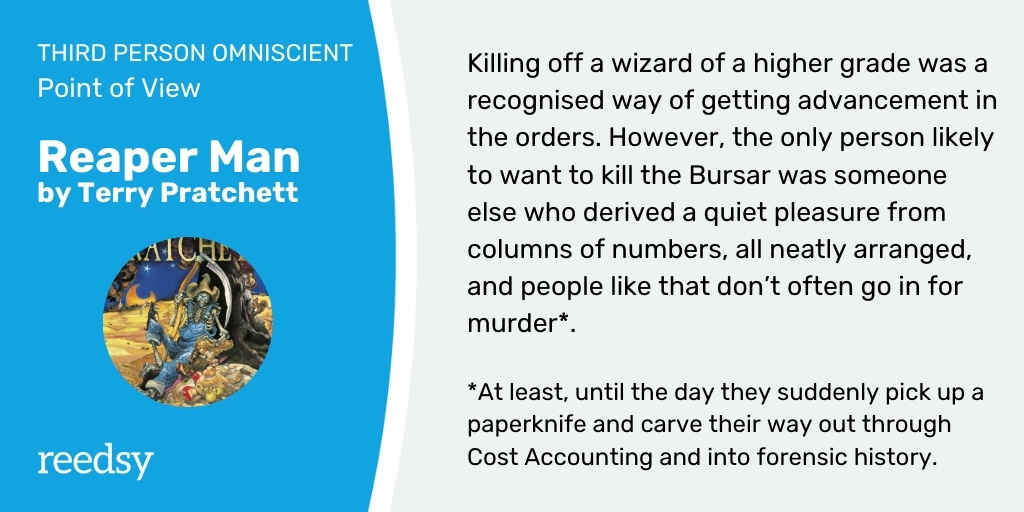
In the passage above, Pratchett describes an element of Discworld lore and provides an additional footnote, adding a playful dimension to his work. That this writing is unencumbered from a character's narrative means the narrative can 'break away' from the action and provide a commentary on events.
Howl's Moving Castle also demonstrates how third person omniscient can easily convey new information:
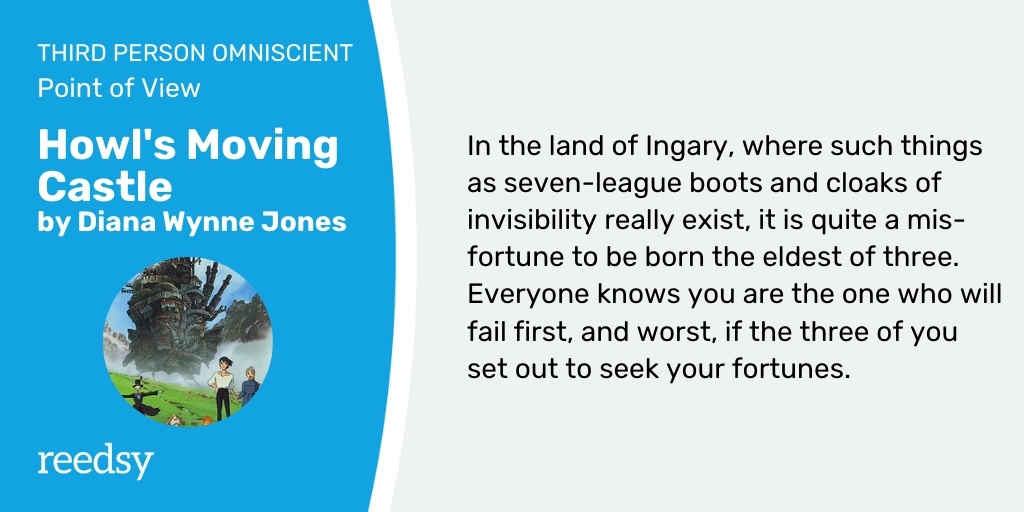
Lots of books choose third person omniscient as their go-to — because you can pan into the finer details of a story or character, and pan out to the bigger picture, revealing important information and events that might be outside the protagonists comprehension, but add rich texture to a plot. For works of fantasy like Howl's Moving Castle, this is really helpful — world-building necessitates rich descriptions of the appearance, values and lore of the fantasy world, and it can seem unnatural for this to come all from a single character.
Why is point of view important in writing?
Now that we've had a closer look at the types of point of view, let's talk about why POV is important.
It determines "psychic distance"
Psychic distance, also called narrative distance, an idea developed in James Gardner's The Art of Fiction, is all about where the narrative (and therefore the reader) stands in relation to the character. It's important to think about how much 'distance' you want to cultivate between your reader and the story. It'll impact the tone of your book, how much (and what) information is shared with the reader, and how plot development occurs.
Some stories will invite close psychic distance, particularly if a novel grapples with emotional themes (like a coming-of-age story) — others might want to establish more 'distance' so that a more objective point of view can be shared with the reader in the style of a commentary.

It contributes to atmosphere
The emotional layer of narration will affect the overall tone and mood of a story. We've all met people that can walk into a room and immediately change its mood, right? A similar thing happens with narration — whoever recounts the story changes the atmosphere with the way they tell the story.
The pensive, somewhat morose narration of Lenù in Elena Ferrante's Neapolitan Quartet, for example, contributes heavily to the contemplative and immersive atmosphere of the novels. The stories would've been much different if Lenù vivacious, confident friend Lila had been recounting the story of their lives together — and as a narrator, she would've placed emphasis on different things, too.
It signals the storytelling style
The voice chosen to narrate the story will determine how it is perceived by the reader. For first and third person especially, we are tapping into a character's mind. It's not just the character's emotions and thoughts that the reader will experience: it's also their manner of talking and thinking. What's the range of their vocabulary, for instance? What do they ponder the most? Are they accustomed to thinking in long spiels or short sentences?
For genres that require more description or technical detail, particular points of view might not be suitable — it would arguably be strange to have a character explain absolutely everything about the world they live in, because that's not how people would act in real life — and in that instance, a third person omniscient narrator would be more appropriate.
As you can see, certain points of view suit certain genres, which we've elaborated on below.
Common POVs in popular genres
When certain POVs are common in a genre, there tends to be some kind of logic behind it. For example, modern detective novels rarely have omniscient narrators, because the fun of reading a detective story is in attempting to solve the mystery alongside the protagonist.
Alternatively, Young Adult novels are often in the first person — these books tend to be more introspective and protagonist-oriented because they express personal coming-of-age experiences, and therefore suit a POV that allows the main characters' voices to come to the fore — emulating the confessional tone of teenage diaries. So, when writing a novel, it's wise to think about your chosen genre and what type of POV it might work well with. Here are a few examples of genres with common viewpoints:
- Young Adult — First person is popular, but third person limited is also common
- Epic Fantasy — Third person omniscient and limited
- Mystery and Thriller — Third person limited
- Romance — First person and third person limited
- Drama — all POVs common
Now that you have the lay of the land (when it comes to POV), head over to the next post in this guide where we'll learn more about first person point of view.
Which Of The Following Words Suggests A Point Of View?
Source: https://blog.reedsy.com/guide/point-of-view/
Posted by: humphreyhunty1956.blogspot.com

0 Response to "Which Of The Following Words Suggests A Point Of View?"
Post a Comment